Курсовая работа: Airfoils and Lift
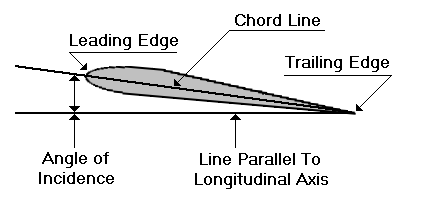
The angle of incidence is measured by the angle at which the wing is attached to the fuselage.
An airfoil is a device which gets a useful reaction from air moving over its surface. When an airfoil is moved through the air, it is capable of producing lift. Wings, horizontal tail surfaces, vertical tails surfaces, and propellers are all examples of airfoils.
Generally the wing of small aircraft will look like the cross-section of the figure above. The forward part of an airfoil is rounded and is called the leading edge. The aft part is narrow and tapered and is called the trailing edge. A reference line often used in discussing airfoils is the chord, an imaginary straight line joining the extremities of the leading and trailing edges.
Angle of Incidence: The angle of incidence is the angle formed by the longitudinal axis of the airplane and the chord of the wing. The longitudinal axis is an imaginary line that extends lengthwise through the fuselage from nose to tail. The angle of incidence is measured by the angle at which the wing is attached to the fuselage. The angle of incidence is fixed --it normally cannot be changed by the pilot. (An exception is the Vought F8U Crusader.)
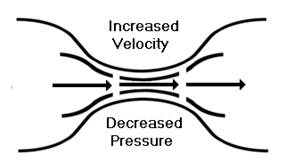
Bernoulli's Principle: To understand how lift is produced, we must examine a phenomenon discovered many years ago by the scientist Bernoulli and later called Bernoulli's Principle: The pressure of a fluid (liquid or gas) decreases at points where the speed of the fluid increases. In other words, Bernoulli found that within the same fluid, in this case air, high speed flow is associated with low pressure, and low speed flow with high pressure. This principle was first used to explain changes in the pressure of fluid flowing within a pipe whose cross-sectional area varied. In the wide section of the gradually narrowing pipe, the fluid moves at low speed, producing high pressure. As the pipe narrows it must contain the same amount of fluid. In this narrow section, the fluid moves at high speed, producing low pressure.
An important application of this phenomenon is made in giving lift to the wing of an airplane, an airfoil. The airfoil is designed to increase the velocity of the airflow above its surface, thereby decreasing pressure above the airfoil. Simultaneously, the impact of the air on the lower surface of the airfoil increases the pressure below. This combination of pressure decrease above and increase below produces lift.
Lift: Probably you have held your flattened hand out of the window of a moving automobile. As you inclined your hand to the wind, the force of air pushed against it forcing your hand to rise. The airfoil (in this case, your hand) was deflecting the wind which, in turn, created an equal and opposite dynamic pressure on the lower surface of the airfoil, forcing it up and back. The upward component of this force is lift; the backward component is drag.

Pressure is reduced is due to the smaller space the air has above the wing than below. Air cannot go through the wing, so it must push around it. The surface air molecules push between the wing and outer layers of air. Due to the bump of the airfoil, the space is smaller and the molecules must go faster. According to Bernoulli's Law, faster air has lower air pressure, and thus the high pressure beneath the wing pushes up to cause lift.
How Airplanes Fly: A Physical Description of Lift c
Fermi National Accelerator Laboratory
Batavia IL 60510
dfa@fnal.gov
&
Scott Eberhardt
Dept. of Aeronautics and Astronautics
University of Washington
Seattle WA 91895-2400
scott@aa.washington.edu
Almost everyone today has flown in an airplane. Many ask the simple question "what makes an airplane fly"? The answer one frequently gets is misleading and often just plain wrong. We hope that the answers provided here will clarify many misconceptions about lift and that you will adopt our explanation when explaining lift to others. We are going to show you that lift is easier to understand if one starts with Newton rather than Bernoulli. We will also show you that the popular explanation that most of us were taught is misleading at best and that lift is due to the wing diverting air down.
Let us start by defining three descriptions of lift commonly used in textbooks and training manuals. The first we will call the Mathematical Aerodynamics Description which is used by aeronautical engineers. This description uses complex mathematics and/or computer simulations to calculate the lift of a wing. These are design tools which are powerful for computing lift but do not lend themselves to an intuitive understanding of flight.
The second description we will call the Popular Explanation which is based on the Bernoulli principle. The primary advantage of this description is that it is easy to understand and has been taught for many years. Because of its simplicity, it is used to describe lift in most flight training manuals. The major disadvantage is that it relies on the "principle of equal transit times" which is wrong. This description focuses on the shape of the wing and prevents one from understanding such important phenomena as inverted flight, power, ground effect, and the dependence of lift on the angle of attack of the wing.
The third description, which we are advocating here, we will call the Physical Description of lift. This description is based primarily on Newton’s laws. The physical description is useful for understanding flight, and is accessible to all who are curious. Little math is needed to yield an estimate of many phenomena associated with flight. This description gives a clear, intuitive understanding of such phenomena as the power curve, ground effect, and high-speed stalls. However, unlike the mathematical aerodynamics description, the physical description has no design or simulation capabilities.
The popular explanation of lift
Students of physics and aerodynamics are taught that airplanes fly as a result of Bernoulli’s principle, which says that if air speeds up the pressure is lowered. Thus a wing generates lift because the air goes faster over the top creating a region of low pressure, and thus lift. This explanation usually satisfies the curious and few challenge the conclusions. Some may wonder why the air goes faster over the top of the wing and this is where the popular explanation of lift falls apart.
In order to explain why the air goes faster over the top of the wing, many have resorted to the geometric argument that the distance the air must travel is directly related to its speed. The usual claim is that when the air separates at the leading edge, the part that goes over the top must converge at the trailing edge with the part that goes under the bottom. This is the so-called "principle of equal transit times".
As discussed by Gail Craig (Stop Abusing Bernoulli! How Airplanes Really Fly, Regenerative Press, Anderson, Indiana, 1997), let us assume that this argument were true. The average speeds of the air over and under the wing are easily determined because we can measure the distances and thus the speeds can be calculated. From Bernoulli’s principle, we can then determine the pressure forces and thus lift. If we do a simple calculation we would find that in order to generate the required lift for a typical small airplane, the distance over the top of the wing must be about 50% longer than under the bottom. Figure 1 shows what such an airfoil would look like. Now, imagine what a Boeing 747 wing would have to look like!
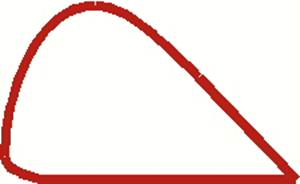
Fig 1 Shape of wing predicted by principle of equal transit time.
If we look at the wing of a typical small plane, which has a top surface that is 1.5 - 2.5% longer than the bottom, we discover that a Cessna 172 would have to fly at over 400 mph to generate enough lift. Clearly, something in this description of lift is flawed.
But, who says the separated air must meet at the trailing edge at the same time? Figure 2 shows the airflow over a wing in a simulated wind tunnel. In the simulation, colored smoke is introduced periodically. One can see that the air that goes over the top of the wing gets to the trailing edge considerably before the air that goes under the wing. In fact, close inspection shows that the air going under the wing is slowed down from the "free-stream" velocity of the air. So much for the principle of equal transit times.
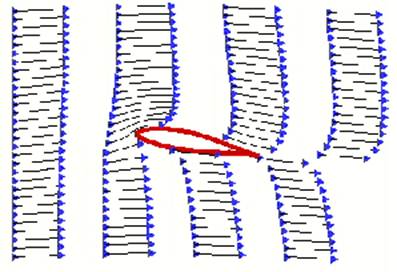
Fig 2 Simulation of the airflow over a wing in a wind tunnel, with colored "smoke" to show the acceleration and deceleration of the air.
The popular explanation also implies that inverted flight is impossible. It certainly does not address acrobatic airplanes, with symmetric wings (the top and bottom surfaces are the same shape), or how a wing adjusts for the great changes in load such as when pulling out of a dive or in a steep turn.
So, why has the popular explanation prevailed for so long? One answer is that the Bernoulli principle is easy to understand. There is nothing wrong with the Bernoulli principle, or with the statement that the air goes faster over the top of the wing. But, as the above discussion suggests, our understanding is not complete with this explanation. The problem is that we are missing a vital piece when we apply Bernoulli’s principle. We can calculate the pressures around the wing if we know the speed of the air over and under the wing, but how do we determine the speed?
Another fundamental shortcoming of the popular explanation is that it ignores the work that is done. Lift requires power (which is work per time). As will be seen later, an understanding of power is key to the understanding of many of the interesting phenomena of lift.
Newton’s laws and lift
So, how does a wing generate lift? To begin to understand lift we must return to high school physics and review Newton’s first and third laws. (We will introduce Newton’s second law a little later.) Newton’s first law states a body at rest will remain at rest, and a body in motion will continue in straight-line motion unless subjected to an external applied force. That means, if one sees a bend in the flow of air, or if air originally at rest is accelerated into motion, there is a force acting on it. Newton’s third law states that for every action there is an equal and opposite reaction. As an example, an object sitting on a table exerts a force on the table (its weight) and the table puts an equal and opposite force on the object to hold it up. In order to generate lift a wing must do something to the air. What the wing does to the air is the action while lift is the reaction.
Let’s compare two figures used to show streams of air (streamlines) over a wing. In figure 3 the air comes straight at the wing, bends around it, and then leaves straight behind the wing. We have all seen similar pictures, even in flight manuals. But, the air leaves the wing exactly as it appeared ahead of the wing. There is no net action on the air so there can be no lift! Figure 4 shows the streamlines, as they should be drawn. The air passes over the wing and is bent down. The bending of the air is the action. The reaction is the lift on the wing.

Fig 3 Common depiction of airflow over a wing. This wing has no lift.

Fig 4 True airflow over a wing with lift, showing upwash and downwash.
The wing as a pump
As Newton’s laws suggest, the wing must change something of the air to get lift. Changes in the air’s momentum will result in forces on the wing. To generate lift a wing must divert air down, lots of air.
The lift of a wing is equal to the change in momentum of the air it diverts down. Momentum is the product of mass and velocity. The lift of a wing is proportional to the amount of air diverted down times the downward velocity of that air. Its that simple. (Here we have used an alternate form of Newton’s second law that relates the acceleration of an object to its mass and to the force on it, F=ma) For more lift the wing can either divert more air (mass) or increase its downward velocity. This downward velocity behind the wing is called "downwash". Figure 5 shows how the downwash appears to the pilot (or in a wind tunnel). The figure also shows how the downwash appears to an observer on the ground watching the wing go by. To the pilot the air is coming off the wing at roughly the angle of attack. To the observer on the ground, if he or she could see the air, it would be coming off the wing almost vertically. The greater the angle of attack, the greater the vertical velocity. Likewise, for the same angle of attack, the greater the speed of the wing the greater the vertical velocity. Both the increase in the speed and the increase of the angle of attack increase the length of the vertical arrow. It is this vertical velocity that gives the wing lift.

Fig 5 How downwash appears to a pilot and to an observer on the ground.
As stated, an observer on the ground would see the air going almost straight down behind the plane. This can be demonstrated by observing the tight column of air behind a propeller, a household fan, or under the rotors of a helicopter, all of which are rotating wings. If the air were coming off the blades at an angle the air would produce a cone rather than a tight column. If a plane were to fly over a very large scale, the scale would register the weight of the plane.
If we estimate the average vertical component of the downwash of a Cessna 172 traveling at 110 knots to be about 9 knots, then to generate the needed 2,300 lbs of lift the wing pumps a whopping 2.5 ton/sec of air! In fact, as will be discussed later, this estimate may be as much as a factor of two too low. The amount of air pumped down for a Boeing 747 to create lift for its roughly 800,000 pounds takeoff weight is incredible indeed.
Pumping, or diverting, so much air down is a strong argument against lift being just a surface effect as implied by the popular explanation. In fact, in order to pump 2.5 ton/sec the wing of the Cessna 172 must accelerate all of the air within 9 feet above the wing. (Air weighs about 2 pounds per cubic yard at sea level.) Figure 6 illustrates the effect of the air being diverted down from a wing. A huge hole is punched through the fog by the downwash from the airplane that has just flown over it.
So how does a thin wing divert so much air? When the air is bent around the top of the wing, it pulls on the air above it accelerating that air down, otherwise there would be voids in the air left above the wing. Air is pulled from above to prevent voids. This pulling causes the pressure to become lower above the wing. It is the acceleration of the air above the wing in the downward direction that gives lift. (Why the wing bends the air with enough force to generate lift will be discussed in the next section.)
As seen in figure 4, a complication in the picture of a wing is the effect of "upwash" at the leading edge of the wing. As the wing moves along, air is not only diverted down at the rear of the wing, but air is pulled up at the leading edge. This upwash actually contributes to negative lift and more air must be diverted down to compensate for it. This will be discussed later when we consider ground effect.
Normally, one looks at the air flowing over the wing in the frame of reference of the wing. In other words, to the pilot the air is moving and the wing is standing still. We have already stated that an observer on the ground would see the air coming off the wing almost vertically. But what is the air doing above and below the wing? Figure 7 shows an instantaneous snapshot of how air molecules are moving as a wing passes by. Remember in this figure the air is initially at rest and it is the wing moving. Ahead of the leading edge, air is moving up (upwash). At the trailing edge, air is diverted down (downwash). Over the top the air is accelerated towards the trailing edge. Underneath, the air is accelerated forward slightly, if at all.
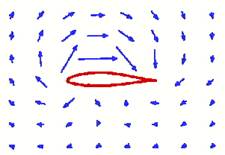
Fig 7 Direction of air movement around a wing as seen by an observer on the ground.
In the mathematical aerodynamics description of lift this rotation of the air around the wing gives rise to the "bound vortex" or "circulation" model. The advent of this model, and the complicated mathematical manipulations associated with it, leads to the direct understanding of forces on a wing. But, the mathematics required typically takes students in aerodynamics some time to master.
One observation that can be made from figure 7 is that the top surface of the wing does much more to move the air than the bottom. So the top is the more critical surface. Thus, airplanes can carry external stores, such as drop tanks, under the wings but not on top where they would interfere with lift. That is also why wing struts under the wing are common but struts on the top of the wing have been historically rare. A strut, or any obstruction, on the top of the wing would interfere with the lift.
Air has viscosity
The natural question is "how does the wing divert the air down?" When a moving fluid, such as air or water, comes into contact with a curved surface it will try to follow that surface. To demonstrate this effect, hold a water glass horizontally under a faucet such that a small stream of water just touches the side of the glass. Instead of flowing straight down, the presence of the glass causes the water to wrap around the glass as is shown in figure 8. This tendency of fluids to follow a curved surface is known as the Coanda effect. From Newton’s first law we know that for the fluid to bend there must be a force acting on it. From Newton’s third law we know that the fluid must put an equal and opposite force on the object that caused the fluid to bend.
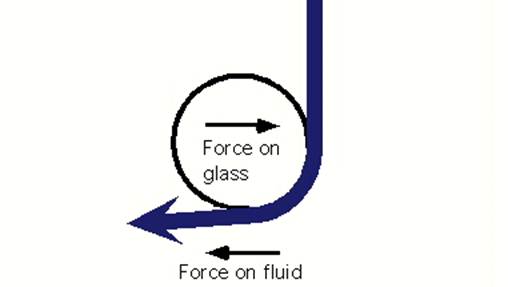
Fig 8 Coanda effect.
Why should a fluid follow a curved surface? The answer is viscosity: the resistance to flow which also gives the air a kind of "stickiness." Viscosity in air is very small but it is enough for the air molecules to want to stick to the surface. The relative velocity between the surface and the nearest air molecules is exactly zero. (That is why one cannot hose the dust off of a car and why there is dust on the backside of the fans in a wind tunnel.) Just above the surface the fluid has some small velocity. The farther one goes from the surface the faster the fluid is moving until the external velocity is reached (note that this occurs in less than an inch). Because the fluid near the surface has a change in velocity, the fluid flow is bent towards the surface. Unless the bend is too tight, the fluid will follow the surface. This volume of air around the wing that appears to be partially stuck to the wing is called the "boundary layer".
Lift as a function of angle of attack
There are many types of wing: conventional, symmetric, conventional in inverted flight, the early biplane wings that looked like warped boards, and even the proverbial "barn door." In all cases, the wing is forcing the air down, or more accurately pulling air down from above. What all of these wings have in common is an angle of attack with respect to the oncoming air. It is this angle of attack that is the primary parameter in determining lift. The lift of the inverted wing can be explained by its angle of attack, despite the apparent contradiction with the popular explanation involving the Bernoulli principle. A pilot adjusts the angle of attack to adjust the lift for the speed and load. The popular explanation of lift which focuses on the shape of the wing gives the pilot only the speed to adjust.
To better understand the role of the angle of attack it is useful to introduce an "effective" angle of attack, defined such that the angle of the wing to the oncoming air that gives zero lift is defined to be zero degrees. If one then changes the angle of attack both up and down one finds that the lift is proportional to the angle. Figure 9 shows the coefficient of lift (lift normalized for the size of the wing) for a typical wing as a function of the effective angle of attack. A similar lift versus angle of attack relationship is found for all wings, independent of their design. This is true for the wing of a 747 or a barn door. The role of the angle of attack is more important than the details of the airfoil’s shape in understanding lift.
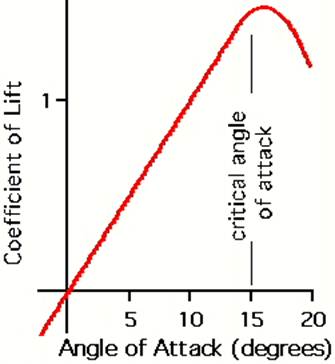
Fig 9 Coefficient of lift versus the effective angle of attack.
Typically, the lift begins to decrease at an angle of attack of about 15 degrees. The forces necessary to bend the air to such a steep angle are greater than the viscosity of the air will support, and the air begins to separate from the wing. This separation of the airflow from the top of the wing is a stall.
The wing as air "scoop"
We now would like to introduce a new mental image of a wing. One is used to thinking of a wing as a thin blade that slices though the air and develops lift somewhat by magic. The new image that we would like you to adopt is that of the wing as a scoop diverting a certain amount of air from the horizontal to roughly the angle of attack, as depicted in figure 10. The scoop can be pictured as an invisible structure put on the wing at the factory. The length of the scoop is equal to the length of the wing and the height is somewhat related to the chord length (distance from the leading edge of the wing to the trailing edge). The amount of air intercepted by this scoop is proportional to the speed of the plane and the density of the air, and nothing else.
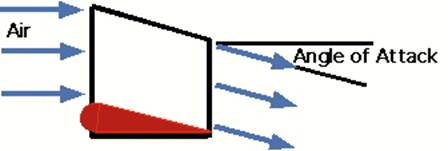
Fig 10 The wing as a scoop.
As stated before, the lift of a wing is proportional to the amount of air diverted down times the vertical velocity of that air. As a plane increases speed, the scoop diverts more air. Since the load on the wing, which is the weight of the plane, does not increase the vertical speed of the diverted air must be decreased proportionately. Thus, the angle of attack is reduced to maintain a constant lift. When the plane goes higher, the air becomes less dense so the scoop diverts less air for the same speed. Thus, to compensate the angle of attack must be increased. The concepts of this section will be used to understand lift in a way not possible with the popular explanation.
Lift requires power
When a plane passes overhead the formerly still air ends up with a downward velocity. Thus, the air is left in motion after the plane leaves. The air has been given energy. Power is energy, or work, per time. So, lift must require power. This power is supplied by the airplane’s engine (or by gravity and thermals for a sailplane).
How much power will we need to fly? The power needed for lift is the work (energy) per unit time and so is proportional to the amount of air diverted down times the velocity squared of that diverted air. We have already stated that the lift of a wing is proportional to the amount of air diverted down times the downward velocity of that air. Thus, the power needed to lift the airplane is proportional to the load (or weight) times the vertical velocity of the air. If the speed of the plane is doubled the amount of air diverted down doubles. Thus the angle of attack must be reduced to give a vertical velocity that is half the original to give the same lift. The power required for lift has been cut in half. This shows that the power required for lift becomes less as the airplane's speed increases. In fact, we have shown that this power to create lift is proportional to one over the speed of the plane.
But, we all know that to go faster (in cruise) we must apply more power. So there must be more to power than the power required for lift. The power associated with lift, described above, is often called the "induced" power. Power is also needed to overcome what is called "parasitic" drag, which is the drag associated with moving the wheels, struts, antenna, etc. through the air. The energy the airplane imparts to an air molecule on impact is proportional to the speed squared. The number of molecules struck per time is proportional to the speed. Thus the parasitic power required to overcome parasitic drag increases as the speed cubed.
Figure 11 shows the power curves for induced power, parasitic power, and total power which is the sum of induced power and parasitic power. Again, the induced power goes as one over the speed and the parasitic power goes as the speed cubed. At low speed the power requirements of flight are dominated by the induced power. The slower one flies the less air is diverted and thus the angle of attack must be increased to maintain lift. Pilots practice flying on the "backside of the power curve" so that they recognize that the angle of attack and the power required to stay in the air at very low speeds are considerable.
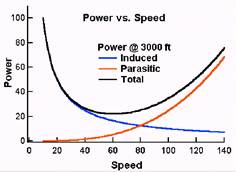
Fig 11 Power requirements versus speed.
At cruise, the power requirement is dominated by parasitic power. Since this goes as the speed cubed an increase in engine size gives one a faster rate of climb but does little to improve the cruise speed of the plane.
Since we now know how the power requirements vary with speed, we can understand drag, which is a force. Drag is simply power divided by speed. Figure 12 shows the induced, parasitic, and total drag as a function of speed. Here the induced drag varies as one over speed squared and parasitic drag varies as the speed squared. Taking a look at these curves one can deduce a few things about how airplanes are designed. Slower airplanes, such as gliders, are designed to minimize induced drag (or induced power), which dominates at lower speeds. Faster airplanes are more concerned with parasitic drag (or parasitic power).
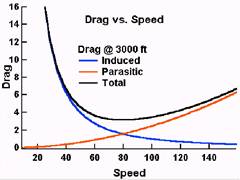
Fig 12 Drag versus speed.
Wing efficiency
At cruise, a non-negligible amount of the drag of a modern wing is induced drag. Parasitic drag, which dominates at cruise, of a Boeing 747 wing is only equivalent to that of a 1/2-inch cable of the same length. One might ask what affects the efficiency of a wing. We saw that the induced power of a wing is proportional to the vertical velocity of the air. If the length of a wing were to be doubled, the size of our scoop would also double, diverting twice as much air. So, for the same lift the vertical velocity (and thus the angle of attack) would have to be halved. Since the induced power is proportional to the vertical velocity of the air, it too is reduced by half. Thus, the lifting efficiency of a wing is proportional to one over the length of the wing. The longer the wing the less induced power required to produce the same lift, though this is achieved with an increase in parasitic drag. Low speed airplanes are affected more by induced drag than fast airplanes and so have longer wings. That is why sailplanes, which fly at low speeds, have such long wings. High-speed fighters, on the other hand, feel the effects of parasitic drag more than our low speed trainers. Therefore, fast airplanes have shorter wings to lower parasite drag.
There is a misconception held by some that lift does not require power. This comes from aeronautics in the study of the idealized theory of wing sections (airfoils). When dealing with an airfoil, the picture is actually that of a wing with infinite span. Since we have seen that the power necessary for lift is proportional to one over the length of the wing, a wing of infinite span does not require power for lift. If lift did not require power airplanes would have the same range full as they do empty, and helicopters could hover at any altitude and load. Best of all, propellers (which are rotating wings) would not require power to produce thrust. Unfortunately, we live in the real world where both lift and propulsion require power.
Power and wing loading
Let us now consider the relationship between wing loading and power. Does it take more power to fly more passengers and cargo? And, does loading affect stall speed? At a constant speed, if the wing loading is increased the vertical velocity must be increased to compensate. This is done by increasing the angle of attack. If the total weight of the airplane were doubled (say, in a 2-g turn) the vertical velocity of the air is doubled to compensate for the increased wing loading. The induced power is proportional to the load times the vertical velocity of the diverted air, which have both doubled. Thus the induced power requirement has increased by a factor of four! The same thing would be true if the airplane’s weight were doubled by adding more fuel, etc.
One way to measure the total power is to look at the rate of fuel consumption. Figure 13 shows the fuel consumption versus gross weight for a large transport airplane traveling at a constant speed (obtained from actual data). Since the speed is constant the change in fuel consumption is due to the change in induced power. The data are fitted by a constant (parasitic power) and a term that goes as the load squared. This second term is just what was predicted in our Newtonian discussion of the effect of load on induced power.
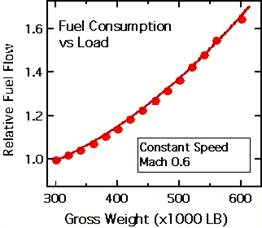
Fig 13 Fuel consumption versus load for a large transport airplane traveling at a constant speed.
The increase in the angle of attack with increased load has a downside other than just the need for more power. As shown in figure 9 a wing will eventually stall when the air can no longer follow the upper surface, that is, when the critical angle is reached. Figure 14 shows the angle of attack as a function of airspeed for a fixed load and for a 2-g turn. The angle of attack at which the plane stalls is constant and is not a function of wing loading. The stall speed increases as the square root of the load. Thus, increasing the load in a 2-g turn increases the speed at which the wing will stall by 40%. An increase in altitude will further increase the angle of attack in a 2-g turn. This is why pilots practice "accelerated stalls" which illustrate that an airplane can stall at any speed. For any speed there is a load that will induce a stall.

Fig 14 Angle of attack versus speed for straight and level flight and for a 2-g turn.
Wing vortices
One might ask what the downwash from a wing looks like. The downwash comes off the wing as a sheet and is related to the details of the load distribution on the wing. Figure 15 shows, through condensation, the distribution of lift on an airplane during a high-g maneuver. From the figure one can see that the distribution of load changes from the root of the wing to the tip. Thus, the amount of air in the downwash must also change along the wing. The wing near the root is "scooping" up much more air than the tip. Since the root is diverting so much air the net effect is that the downwash sheet will begin to curl outward around itself, just as the air bends around the top of the wing because of the change in the velocity of the air. This is the wing vortex. The tightness of the curling of the wing vortex is proportional to the rate of change in lift along the wing. At the wing tip the lift must rapidly become zero causing the tightest curl. This is the wing tip vortex and is just a small (though often most visible) part of the wing vortex. Returning to figure 6 one can clearly see the development of the wing vortices in the downwash as well as the wing tip vortices.
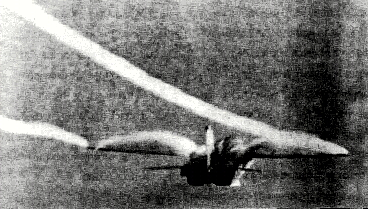
Fig 15 Condensation showing the distribution of lift along a wing. The wingtip vortices are also seen. (from Patterns in the Sky, J.F. Campbell and J.R. Chambers, NASA SP-514.)
Winglets (those small vertical extensions on the tips of some wings) are used to improve the efficiency of the wing by increasing the effective length of the wing. The lift of a normal wing must go to zero at the tip because the bottom and the top communicate around the end. The winglets blocks this communication so the lift can extend farther out on the wing. Since the efficiency of a wing increases with length, this gives increased efficiency. One caveat is that winglet design is tricky and winglets can actually be detrimental if not properly designed.
Ground effect
Another common phenomenon that is misunderstood is that of ground effect. That is the increased efficiency of a wing when flying within a wing length of the ground. A low-wing airplane will experience a reduction in drag by 50% just before it touches down. There is a great deal of confusion about ground effect. Many pilots (and the FAA VFR Exam-O-Gram No. 47) mistakenly believe that ground effect is the result of air being compressed between the wing and the ground.
To understand ground effect it is necessary to have an understanding of upwash. For the pressures involved in low speed flight, air is considered to be non-compressible. When the air is accelerated over the top of the wing and down, it must be replaced. So some air must shift around the wing (below and forward, and then up) to compensate, similar to the flow of water around a canoe paddle when rowing. This is the cause of upwash.
As stated earlier, upwash is accelerating air in the wrong direction for lift. Thus a greater amount of downwash is necessary to compensate for the upwash as well as to provide the necessary lift. Thus more work is done and more power required. Near the ground the upwash is reduced because the ground inhibits the circulation of the air under the wing. So less downwash is necessary to provide the lift. The angle of attack is reduced and so is the induced power, making the wing more efficient.
Earlier, we estimated that a Cessna 172 flying at 110 knots must divert about 2.5 ton/sec to provide lift. In our calculations we neglected the upwash. From the magnitude of ground effect, it is clear that the amount of air diverted is probably more like 5 ton/sec.
Conclusions
Let us review what we have learned and get some idea of how the physical description has given us a greater ability to understand flight. First what have we learned:
· The amount of air diverted by the wing is proportional to the speed of the wing and the air density.
· The vertical velocity of the diverted air is proportional to the speed of the wing and the angle of attack.
· The lift is proportional to the amount of air diverted times the vertical velocity of the air.
· The power needed for lift is proportional to the lift times the vertical velocity of the air.
Now let us look at some situations from the physical point of view and from the perspective of the popular explanation.
· The plane’s speed is reduced. The physical view says that the amount of air diverted is reduced so the angle of attack is increased to compensate. The power needed for lift is also increased. The popular explanation cannot address this.
· The load of the plane is increased. The physical view says that the amount of air diverted is the same but the angle of attack must be increased to give additional lift. The power needed for lift has also increased. Again, the popular explanation cannot address this.
· A plane flies upside down. The physical view has no problem with this. The plane adjusts the angle of attack of the inverted wing to give the desired lift. The popular explanation implies that inverted flight is impossible.
As one can see, the popular explanation, which fixates on the shape of the wing, may satisfy many but it does not give one the tools to really understand flight. The physical description of lift is easy to understand and much more powerful.
Axis of Rotation

Axis of an Airplane in Flight.
An airplane may turn about three axes. Whenever the attitude of the airplane changes in flight (with respect to the ground or other fixed object), it will rotate about one or more of these axes. Think of these axes as imaginary axles around which the airplane turns like a wheel. The three axes intersect at the center of gravity and each one is perpendicular to the other two.
Longitudinal Axis: The imaginary line that extends lengthwise through the fuselage, from nose to tail, is the longitudinal axis. Motion about the longitudinal axis is roll and is produced by movement of the ailerons located at the trailing edges of the wings.
Lateral Axis: The imaginary line which extends crosswise, wing tip to wing tip, is the lateral axis. Motion about the lateral axis is pitch and is produced by movement of the elevators at the rear of the horizontal tail assembly.
Vertical Axis: The imaginary line which passes vertically through the center of gravity is the vertical axis. Motion about the vertical axis is yaw and is produced by movement of the rudder located at the rear of the vertical tail assembly.
DETAILS OF MODERN AIRSHIPS - 1927
Advantages of Rigid Type Airships--Airship Frame Construction--Large Airships Projected--Army Non-rigid Dirigibles--Requirements of Airships for Civilian Flying.
Advantages of Rigid Type Airship. Before describing typical lighter- than-air craft or airships that have received actual commercial as well as military usage, it may be well to briefly review some of the advantages of the rigid type, which is the one that lends itself most easily to large structures and which is also the safest of the three types we have previously reviewed in Chapter II which is devoted to a consideration of the elementary principles underlying airship construction and application. Rigid airships have made longer single flights than other types and have flown more hours and miles without refueling than any other form. The rigid airship is said to be the fastest large vehicle of transportation that engineering ability of man has yet evolved. The Navy Airship Los Angeles, shown near the mooring mast at Lakehurst, N. J. to which it may be anchored is depicted at Fig. 315. A design of the new 6,500,000 cubic foot capacity ship recently authorized by Congress is shown at Fig. 316 flying over a battleship at an elevation of about 1,500 feet. The rigid airship, owing to its large size and light weight can carry more load than any other type of aircraft. It is independent of topography as oceans and continents are but areas to fly over. Land vehicles must stop when they reach water, water transport must stop when the ship is docked.
Airship Frame Construction. The rigid airship, because of its bulkhead system, in which the lifting gas is carried in 16 to 20 cells, has a much greater safety factor than the types in which the gas is carried in only one or two containers. In event of damage to one or two cells, the ship can continue its journey and repairs can be made to a leaky gas cell while in flight.
The rigid ship has a complete metal framework. Girders extend from nose to tail, or in nautical parlance, from stem to stern. Ring girders set at intervals brace the longitudinals and are themselves internally reinforced by cross girders and tension wire bracing. The entire framework is enclosed by a network of wiring and the whole is streamlined or faired to minimize air resistance with a fabric covering.
The view of the crew's quarters on the Bodensee, a German air liner at Fig. 317, shows the triangular keel member with the cat-walk by which the crew can travel from one end of the ship to the other and gain access to the different gas bags. The character of the longitudinal duralumin girders and the way they are braced by the ring girders is clearly shown at Fig. 318. This depicts that portion of the hull where one set of fuel tanks are located. The view at Fig. 319 shows the interior with the deflated gas cells hanging from the top-most longitudinal ready for inflation.
The outer skin is in place and the large size and extreme lightness of the structure is clearly shown. The passenger cabin of the Deutschland, another rigid dirigible of the Zepellin series is shown at Fig. 320. Wicker chairs are used because of their light weight and the interior structure of the cabin can be determined by study of the illustration.
The control of a Zepellin type airship is not as simple as that of an airplane and no one man is at the controls. Special controls are provided for the elevators and still another set for the vertical rudders. The elevator control of the L59 with the instruments for altitude navigation is shown at Fig. 321. Control is by a large wheel similar to the steering wheel of a ship. Directional control is by a similar wheel at another part of the control car.
Large Airship Projected. The largest of the United States Navy airships, the Shenandoah was 600 feet long with a capacity of 2,115,000 cubic feet. The projected airship designed by the engineers of the Goodyear- Zepellin Company, while it has over three times the capacity of the Shenandoah will be only 100 feet longer and will be of such size that it may be housed in the Lakehurst hangar. The illustration at Fig. 322 shows how the new ships authorized by congress will compare with the Shenandoah. The control car will be built into the hull and streamlined. Engines of 4,800 horsepower, giving a speed of 90 miles per hour with fuel for from 5,000 to 8,000 miles will drive the ship. The air screws will be fitted in tilting mountings, which will turn in a 90 degree arc to help force the ship upward or downward as desired and greatly aid in controlling the huge vessel.
It will embody the proved structural advantages of some 135 ships built in the past.
(a) Multiple gas cells which function like bulk-heading on a steamship, so that if one or more cells fail the ship will still remain aloft: (b) The triple cover system, one cover to hold the lifting gas, one consisting of the shape-forming duralumin frame-work, and an outer cover to shed rain and snow, to reflect rather than to absorb heat, and to present a fair surface; (c) invulnerability against lightning; (d) accessibility to inspection and repair.
It will however present certain new features as well of far reaching importance: (a) A double or triple keel giving added longitudinal strength comparable to the breaking strength of one length of metal, as against two or three bolted together; (b) a new type of ring girder each internally braced and structurally self sufficient, which (c) will permit the control car and even the power cars to be built within the hull; (d) even fuller accessiblity to continuous inspection and permitting repairs to be made even in flight; (e) the use of new fuels to conserve helium and reduce weight.
Army Non-Rigid Dirigibles. The non-rigid dirigible is the smallest of the three types as the largest now being built in the United States for the Army and Navy service have a gas capacity of about one-tenth that of the Los Angeles. Under ordinary conditions a 230,000 cubic foot non-rigid has a cruising radius of from 500 to 1,000 miles and an air endurance of from 18 to 24 hours. Such airships are essentially motorized free balloons and the engines are carried in a car attached to the lower side or bottom of the bag. The Pilgrim, a small non-rigid previously described with a gas capacity of 50,000 cubic feet has a speed of 50 miles per hour and is propelled by a Wright "Gale" three-cylinder engine as shown at Fig. 323. This small ship was built to carry four passengers. The gas in non-rigid ships, as in the army TC types, as shown at Fig. 324 is contained in a single bag, but an inner two compartment bag, called the ballonet, is filled with air to keep the main container properly distended because the air pressure can be made to compensate for variations in gas pressure in the bag. These ships have a capacity of about 200,000 cubic feet, are 196 feet long overall and 47 feet in extreme height. The hull diameter is 33.5 feet. The fineness ratio is 4.4 to 1. The total lift is 11,584 pounds of which the useful lift is about 4,000 pounds. The gross weight per horsepower is 38.6 pounds. Two Wright Type I water-cooled engines of 150 horsepower each were provided on the first ships of this series but these have been replaced on later types with two Wright J1 engines, which are nine-cylinder radial air-cooled types driving tractor propellers 9 feet 10 inches in diameter. It is claimed that the saving of 400 pounds over the water-cooled installation permits an increase of speed from 54 to 60 miles per hour; with an increase in range of 10 per cent.
Flight Control Surfaces - Elevons

Delta winged aircraft use elevons as primary flight controls for
roll and pitch.
Elevon: Delta winged aircraft can not use conventional 3 axis flight control systems because of their unique delta shape. Therefore, it uses a device called an elevon. It is a combination of ailerons and elevators.
The elevon is used as an aileron. Ailerons control motion along the longitudinal axis. The longitudinal axis is an imaginary line that runs from the nose to the tail. Motion about the longitudinal axis is called roll.
The elevon is also used as an elevator. Elevators control motion along the lateral axis. The lateral axis is an imaginary line that extends crosswise, from wingtip to wingtip. Motion about the lateral axis is called pitch.
| Fokker DR.I - Thoughts on Wing Failures |
|
by Mike Tate © 2000 |
|
The recent WWI AERO article (#165, Aug, 1999) concerning wing failures in the Nieuport 28 prompted me to put some ideas to paper, regarding those more familiar failures of the Fokker triplane. The reputation of Fokker aircraft for fragility was mainly the result of structural problems with the Dr.I triplane and D.VIII cantilever monoplane. The D.VIII wing problem was due to flexural failure (ie, they broke in bending); and the evidence indicates that this was due to production quality-control inadequacies rather than deficiencies of design or technical understanding. The Dr.I, however, is a different "kettle of fish" in that it experienced failures very like those of the Nieuport 28, namely that of "wing stripping." Unlike the D.VIII, the triplane was grounded not because of spar failure, but because of the disintegration of the secondary structure- wing ribs etc- whilst the spars remained intact. The similarity of the failures in the N28 and Dr.I is intriguing because the 2 aircraft are fundamentally different: one a biplane of almost sesquiplane proportions, the other a triplane of equal-chord wings. The N28 had thin-section wings, wire-braced; the Dr.I had thick sections and a cantilever structure very different animals. For me, the most interesting fact of all (and the most difficult to explain) has been that the failures always occurred in the upper wings of either aircraft - to my knowledge there are no reported incidents of failures in the lower planes. In the case of the 2 most notable triplane failures, the extent of the upper wingstripping was almost total, with fatal consequences for Lieutenants Gontermann and Pastor. It is of particular interest that, after the triplane was reissued with modified wings, the same type of failure still occurred - but to a more limited (and survivable) extent. At the time of the Dr.I grounding, after the 2 crashes mentioned, various theories were proposed to account for the failures. Sand loading of the Fokker F5 (the Dr.I prototype) had shown that the triplane cantilever wing cellule had excellent strength for its period; and it fell to those interested to create new (and unlikely) aerodynamic phenomena to account for the fatal discrepancy between experiment and practice. Because the ailerons of both Gontermann's and Pastor's aircraft were seen to detach, interest centered on the aileron supporting-structure and related internal componentry. Various reinforcements were introduced, and emphasis was placed on better internal protection of the glued structure by varnishing. (The peculiarity of upper wing failures had not, of course, gone unnoticed at the time. The possibility of the casein glue deteriorating, due to weathering, gave cause for concern - the lower wings being considered to be somewhat protected - debatable, of course.) Also poor workmanship was extensively uncovered in grounded aircraft and Fokker was urged to improve on this aspect of his production of further aircraft. However, as noted, failures continued to occur in the reissued aircraft. |
In the case of the Nieuport 28, the fabric of the upper-wing top-surface together with the entire leading edge would detach. On this aircraft, however, damage appears to have been selflimiting at this point: the rib tails and undersurface, for instance, always seem to have held up. This is just as well for the pilots concerned, since the (almost) sesquiplane proportions of the N28 could not have tolerated complete loss of the upper lifting area. Fortunately, the Nieuport carried its ailerons on the lower plane so that roll control was available - no doubt this helped survivability.
Of all WWI aircraft, these 2 are the only ones I am aware of that suffered this type of failure as a generic fault. "Ballooning" of wing fabric was a known risk resulting from wing leading-edge damage. Wings failed simply through lack of strength. Wings failed due to a lack of stiffness. (True sesquiplanes- V-strutters, notably other Nieuport and Albatros models- are known to have occasionally lost a lower plane due to a lack of torsional stiffness) - but wingstripping seems mainly recorded for the 2 models in question. Since wing reinforcement better weather protection and better-built quality did not fully cure the triplane ills, then there was another factor at work. So what was it?
I began by looking for a common factor. What is it that both aircraft possess which can cause almost identical failure in a wing- and why only the top plane? There are in fact, 2 unusual structural features present in both. Firstly, the main spars are very closely spaced so that the rib noses project unusually far forward of the spar group. The N28 spars are closely spaced, but maintain an orthodox drag-bracing arrangement of steel tube and piano wire. The Dr.I located the spars with a small separation, so that plywood closing-skins top and bottom formed a single-spar system, accounting for both drag and to a limited extent, torsion.
The other critical feature present in both aircraft was the use of a plywood leading-edge contour panel. This was relatively unusual in WWI. British aircraft seem not to have used it at all, preferring intermediate riblets as leading-edge support; and from a quick appraisal of my library, I have identified only 5 aircraft which had this feature (I don't suppose this to be at a definitive.). These are the Pfalz D.XII Fokkers Dr.I, D.VI and D.VII, and the Nieuport 28 (possibly also the 27).
Some aircraft wings were, of course, totally skinned in sheet plywood or aluminum; but with these exceptions, at least, complete fabric cover was the norm. The use of plywood leading-edge covering presents a problem in the attachment of fabric since stringing (ie, the through-wing stitching normally used) would be required to stop at the plywood-covered surface. This may account for the fact that both the triplane and N28 are reported as originally having the fabric tacked to the rib flanges rather than being sewn (which was considered to be the correct way). The fabric attachment itself is therefore suspect but the test still remains; why only failures of the upper wing? If the fabric attachment was the critical factor, then failures could have occurred in any wing with this feature, which would have included lower planes of both the triplane and the N28.
Both aircraft have structurally suspect features in their wing leading-edges. In the case of the N28, the long rib-noses would produce large bending stresses (during violent manoeuvres) at their main-spar attachment locations. Large bending stresses can have attendant large shear stresses; and on the N28, these would exist in the thin poplar rib-webs (typical of the period). This is a very risky arrangement, since timber is not particularly strong when subject to shear loading along the grain - plywood is much better. (The N28 rib-noses had very little shear material anyway)
The other suspect feature is that of the omission of rib-capping referred to in the recent WWI AERO article. These details appear peculiar to the N28, and are at the most extreme in the upper wing. There is little doubt that the upper wing leading edge was simply of marginal strength; and at first sight it seems odd that sandloading did not reveal this weakness. But of course this reveals a weakness of sand-loading. The chordwise distribution of lift, at high angles of attack, will not normally be represented by a heap of sand, since dry sand slumps to approximately 45 deg- forming a triangular load distribution with a centrally-located center of gravity. (This can be modified within limits by constructing walls along the wing edges.) Sandloading therefore successfully tests the wingspar adequacy, but is insufficient to the task of testing the rib nose strength (and remember that here we have 2 aircraft which resolutely held on to their spars, whilst liberally shedding secondary structure). This proof-loading problem is exacerbated by the fact that wing lift (particularly at large angles of attack) is largely generated by the negative pressure zone existing on the forward upper surface (see Fig 18- taken from SIMPLE AERODYNAMICS (1929), by Charles N Monteith.).
The critical structural requirement under these loading conditions is to have adequate "peel" strength between the upper skin and the substructure (ribs and/or stringers etc). Both the N28 and the Dr.I were deficient here. The Nieuport was devoid of rib cap-strips or spanwise stringers at the critical location; the Dr.I leading-edge plywood was severely cut away at each rib, had no supporting stringers, and had only minor connection to the main spar. With this arrangement, a significant amount of the local lift- would have been transmitted in a peel condition from the plywood skin to the supporting ribs - there was no other load-path. Again, this is a very unreliable form of joint. Today, the attachment of wing skins to substructure remains a critical factor; in fact, where fuel is carried inside a wing much of the wing design is overridingly determined by this consideration.
So, the Nieuport had a weak upper-wing leading edge and larger chord to boot. This could (as suggested in the WWI AERO article) be the complete answer to the N28 failures. But the Triplane had the same design condition on all wings, but only the top wing ever failed. So there was something else.
It is not common to see a biplane or triplane wing cellule in which equal-chord wings are of differing span, although some famous aircraft such as the BE- 12, RE-8 and Curtiss Jenny are exceptions. Typically, where an upper wing is of greater span, it is often of greater chord also. This has the virtue of approximately maintaining constant aspect-ratio for each wing in the complete wing system. (To what extent this represented a design objective at the time I have no information.)
The fact that real wings are of finite span (as opposed to the theoretically infinite span wing which is implicit in aerofoil section data) means that a real wing will attain a particular lift coefficient at an angle of attack somewhat greater than that apparent from he section-data. It also follows that wings of differing aspect ratio, but identical section, will generate different lift-intensities, to one another, when operating at the same angle of attack.
The Dr.1 had aspect ratios of 6.8, 5.9 and 5.1 for the upper, middle and lower planes respectively. The wing section (tested as the Gottingen 289 section after the war) had a maximum lift coefficient of about 1.4. Making estimates for each of the triplane wings (working as independent surfaces), the planes would require 19.2, 20 and 21 degrees respectively to reach the maximum lift coefficient. When working at the same angle of attack (as in the aircraft alignment), the upper wing would produce a lift intensity about 9% greater than the lower wing. So could aspect-ratio be the cause of the Triplane wing failures? Well no, I am afraid not. A 9% increased lift intensity cannot be considered sufficient to always fail the upper wing before one or the other planes. Variations in material strength and build quality would both have similar (or greater) tolerance, which would occasionally bias the failure to one of the other planes. There has to be something else – something more emphatic.
I found the answer by chance, and I found it in a ‘history’ book. Whilst flipping through a copy of SIMPLE AERODYNAMICS (1929), by Charles N Monteith, (Chief Engineer, Boeing), looking for data on the Gottingen 289 section, I came across a particularly relevant passage under Item 70, p89, “Pressure distribution tests on MB-3A Airplane”, which is reproduced in facsimile here:
Paragraphs B and C are telling. The loading distribution noted is very significant over the biplane system described. A factor of 1.6 at high-lift coefficients cannot be ignored. The Triplane system with its relatively smaller wing gaps and pronounced stagger would almost certainly have a greater value than this. Together with aspect-ratio effects it is not unreasonable to suggest that the lift intensity of the upper wing of the Dr.I approached twice that of the bottom wing. This is certainly enough to test the upper wing integrity before the rest of the system.
Conclusion
I would suggest that the Dr.I wing failures (and almost certainly those of the N28, too) occurred because lift-grading (particularly), together with aspect-ratio effects, caused the upper surface of the upper wing to be subject to much greater lift intensity than the rest of the system. This tested a leading-edge design of marginal strength, poorly made, to the point of collapse in particular aircraft. The leading edge failure continued back across the wing due to design details. Where rib tails, for example, were connected by a wire trailing edge, ballooning fabric will exert tensile loading in this wire which will then tend to "gather up" the rib tails and strip the wing. This would also destabilize the area of the aileron support structures, and so on. The strengthening of the wing aft of the spars and the improvements to build quality, carried out after the original failures, would have acted to prevent this catastrophic failure. But the root cause of the failure lift-grading) went unappreciated until after the war when investigations like those at NACA were conducted.
It would be fascinating to know to what extent these factors were understood prior to 1918. I expect that the concentration of lift forces (as an intense negative pressure zone at the upper surface LE) was reasonably well appreciated by wind-tunnel investigators- if only by the application of Bernoulli's theorem to the visible flow patterns around test sections. Probably the effects of aspect ratio were understood- even if only qualitatively; but lift-grading would require much more complex investigation. Regarding the aspect-ratio issue; advocates of multiplanes (Horatio Phillips, for example) appear to have worked from the understanding that high aspect-ratio is a "good thing" (true) but not to have had evidence of the detrimental effects of interference between closely-spaced multi-plane wing systems.
But such is the nature of progress - the testing of ideas. It took the lives of airmen to drive the investigations which led to today's understanding of these matters and which allow our complacent and sometimes arrogant review of history.
A final thought. It is theoretically possible for the Fokker triplane to remain airborne on its 2 lower planes alone (of 9.9 square metres area). The stall speed would be about 64mph. No doubt, when both Gontermann and Pastor found themselves in dire straits, they did the natural thing: to pull back on the stick even though the aircraft was deeply stalled. Maybe if they had first pushed... ?
Forces Acting on an Airplane
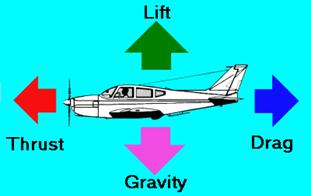
The airplane in straight-and-level unaccelerated flight is acted on by four forces. The four forces are lift, gravity, thrust and drag.
The airplane in straight-and-level unaccelerated flight is acted on by four forces--lift, the upward acting force; weight, or gravity, the downward acting force; thrust, the forward acting force; and drag, the backward acting, or retarding force of wind resistance.
Lift opposes gravity.
Thrust opposes drag.
Drag and weight are forces inherent in anything lifted from the earth and moved through the air. Thrust and lift are artificially created forces used to overcome the forces of nature and enable an airplane to fly. The engine and propeller combination is designed to produce thrust to overcome drag. The wing is designed to produce lift to overcome the weight (or gravity).
In straight-and-level, unaccelerated flight, (Straight-and-level flight is coordinated flight at a constant altitude and heading) lift equals weight and thrust equals drag, though lift and weight will not equal thrust and drag. Any inequality between lift and weight will result in the airplane entering a climb or descent. Any inequality between thrust and drag while maintaining straight-and-level flight will result in acceleration or deceleration until the two forces become balanced.
Flight Control Surfaces

The three primary flight controls are the ailerons, elevator and rudder.
Ailerons: The two ailerons, one at the outer trailing edge of each wing, are movable surfaces that control movement about the longitudinal axis. The movement is roll. Lowering the aileron on one wing raises the aileron on the other. The wing with the lowered aileron goes up because of its increased lift, and the wing with the raised aileron goes down because of its decreased lift. Thus, the effect of moving either aileron is aided by the simultaneous and opposite movement of the aileron on the other wing.
Rods or cables connect the ailerons to each other and to the control wheel (or stick) in the cockpit. When pressure is applied to the right on the control wheel, the left aileron goes down and the right aileron goes up, rolling the airplane to the right. This happens because the down movement of the left aileron increases the wing camber (curvature) and thus increases the angle of attack. The right aileron moves upward and decreases the camber, resulting in a decreased angle of attack. Thus, decreased lift on the right wing and increased lift on the left wing cause a roll and bank to the right.
Elevators: The elevators control the movement of the airplane about its lateral axis. This motion is pitch. The elevators form the rear part of the horizontal tail assembly and are free to swing up and down. They are hinged to a fixed surface--the horizontal stabilizer. Together, the horizontal stabilizer and the elevators form a single airfoil. A change in position of the elevators modifies the camber of the airfoil, which increases or decreases lift.
Like the ailerons, the elevators are connected to the control wheel (or stick) by control cables. When forward pressure is applied on the wheel, the elevators move downward. This increases the lift produced by the horizontal tail surfaces. The increased lift forces the tail upward, causing the nose to drop. Conversely, when back pressure is applied on the wheel, the elevators move upward, decreasing the lift produced by the horizontal tail surfaces, or maybe even producing a downward force. The tail is forced downward and the nose up.
The elevators control the angle of attack of the wings. When back pressure is applied on the control wheel, the tail lowers and the nose raises, increasing the angle of attack. Conversely, when forward pressure is applied, the tail raises and the nose lowers, decreasing the angle of attack.
Rudder: The rudder controls movement of the airplane about its vertical axis. This motion is yaw. Like the other primary control surfaces, the rudder is a movable surface hinged to a fixed surface which, in this case, is the vertical stabilizer, or fin. Its action is very much like that of the elevators, except that it swings in a different plane--from side to side instead of up and down. Control cables connect the rudder to the rudder pedals.
Trim Tabs: A trim tab is a small, adjustable hinged surface on the trailing edge of the aileron, rudder, or elevator control surfaces. Trim tabs are labor saving devices that enable the pilot to release manual pressure on the primary controls.
Some airplanes have trim tabs on all three control surfaces that are adjustable from the cockpit; others have them only on the elevator and rudder; and some have them only on the elevator. Some trim tabs are the ground-adjustable type only.
The tab is moved in the direction opposite that of the primary control surface, to relieve pressure on the control wheel or rudder control. For example, consider the situation in which we wish to adjust the elevator trim for level flight. ("Level flight" is the attitude of the airplane that will maintain a constant altitude.) Assume that back pressure is required on the control wheel to maintain level flight and that we wish to adjust the elevator trim tab to relieve this pressure. Since we are holding back pressure, the elevator will be in the "up" position. The trim tab must then be adjusted downward so that the airflow striking the tab will hold the elevators in the desired position. Conversely, if forward pressure is being held, the elevators will be in the down position, so the tab must be moved upward to relieve this pressure. In this example, we are talking about the tab itself and not the cockpit control.
Rudder and aileron trim tabs operate on the same principle as the elevator trim tab to relieve pressure on the rudder pedals and sideward pressure on the control wheel, respectively.
Laminar Flow Airfoil

Laminar Flow is the smooth, uninterrupted flow of air over the contour of the wings, fuselage, or other parts of an aircraft in flight. Laminar flow is most often found at the front of a streamlined body and is an important factor in flight. If the smooth flow of air is interrupted over a wing section, turbulence is created which results in a loss of lift and a high degree of drag. An airfoil designed for minimum drag and uninterrupted flow of the boundary layer is called a laminar airfoil.
The Laminar flow theory dealt with the development of a symmetrical airfoil section which had the same curvature on both the upper and lower surface. The design was relatively thin at the leading edge and progressively widened to a point of greatest thickness as far aft as possible. The theory in using an airfoil of this design was to maintain the adhesion of the boundary layers of airflow which are present in flight as far aft of the leading edge as possible. on normal airfoils the boundary layer would be interrupted at high speeds and the resultant break would cause a turbulent flow over the remainder of the foil. This turbulence would be realized as drag up the point of maximum speed at which time the control surfaces and aircraft flying characteristics would be affected. The formation of the boundary layer is a process of layers of air formed one next to the other, ie; the term laminar is derived from the lamination principle involved.
History of Laminar Flow The P-51 Mustang is the first aircraft every intentionally designed to use laminar flow airfoils. However, wartime NACA research data I have shows that Mustangs were not manufactured with a sufficient degree of surface quality to maintain much laminar flow on the wing. The RAE found that the P-63, despite being designed with laminar airfoils, also was not manufactured with sufficient surface quality to have much laminar flow.
The Mustang was a mathematically designed airplane and the wing foil that was to be classified as a "semi-empirical venture" by the British was cleared for adoption on the new design. The wing section would be the only part of the fighter which would be tested in a wind tunnel prior to the first test flight. Due to the speculation of the success of the radical foil, the engineering department was committed to adopt a more conventional airfoil within thirty days of the tests in the event the wing did not come up to specifications. A one quarter scale model of the wing was designed and constructed for tests in the wing tunnel at the Caiifornia Institute of Technology.
The use of this airfoil on the Mustang would greatly add to the drag reducing concept that was paramount in all design phases of the airplane. The few applications of this foil, prior to this time, had been handbuilt structures which were finished to exacting tolerances. An absolutely smooth surface was necessary due to the fact that any surface break or rough protrusion would interrupt the airflow and detract from the laminar flow theory. Because of the exactness required, the foil had been shelved by other manufacturers due to the clearances and tolerances which are used in mass production. The engineers at NAA approached this problem with a plan to fill and paint the wing surface to provide the necessary smoothness. The foil which was used for the Mustang had a thickness ratio of 15.1 percent at the wing root at 39 percent of the chord. The tip ratio was 11.4 percent at the 50 percent chord line. These figures provided the maximum thickness area at 40 percent from the leading edge of the wing and resulted in a small negative pressure gradient over the leading 50-60 percent of the wing surface.
The B-24 bomber's "Davis" airfoil was also a laminar flow airfoil, which predates the Mustang's. However, the designers of the B-24 only knew that their airfoil had very low drag in the wind tunnel. They did not know that it was a laminar flow airfoil.
There were several aircraft modified by NACA, in the late 1930s, to have laminar flow test sections on their wings. Hence, such aircraft as a modified B-18 were some of the first aircraft to fly with laminar flow airfoils.
The boundary layer concept is credited to the great German aerodynamicist, Ludwig Prandtl. Prandtl hyposthesized and proved the existence of the boundary layer long before the Mustang was a gleam in anyone's eye.
Example: First, lets get more specific about what laminar flow is. The flow next to any surface forms a "boundary layer", as the flow has zero velocity right at the surface and some distance out from the surface it flows at the same velocity as the local "outside" flow. If this boundary layer flows in parllel layers, with no energy transfer between layers, it is laminar. If there is energy transfer, it is turbulent.
All boundary layers start off as laminar. Many influences can act to destabilize a laminar boundary layer, causing it to transition to turbulent. Adverse pressure gradients, surface roughness, heat and acoustic energy all examples of destabilizing influences. Once the boundary layer transitions, the skin friction goes up. This is the primary result of a turbulent boundary layer. The old "lift loss" myth is just that - a myth.
A favorable pressure gradient is required to maintain laminar flow. Laminar flow airfoils are designed to have long favorable pressure gradients. All airfoils must have adverse pressure gradients on their aft end. The usual definition of a laminar flow airfoil is that the favorable pressure gradient ends somewhere between 30 and 75% of chord.
Now Consider the finish on your car in non-rainy conditions. Dust and leaves have settled on the hood's paint. We go for a drive. At once the leaves blow off. But the dust remains. We speed up. Even if we go very fast, the dust remains because of the thin layer of air that moves with the car. If you drive with dew on your car, the dew will not so quickly be blown dry where the air flow has this thin laminar layer. Downstream, where the laminar flow has become turbulent, the air flow quickly dries the dew.
In the fifties this was dramatically shown in a photograph of the top of a sailplane wing (inflight) that had dew on it. A few tiny seeds had landed on forward area the wing while on the ground. In flight these seeds, tiny though they were, reached through the laminar layer and caused micro-turbulence causing the dew to be blown dried in an expanding vee shaped area down stream of each tiny seed.
Additional information
Profile drag
This comprises two components: surface friction drag and normal pressure drag (form drag).
Surface friction drag
This arises from the tangential stresses due to the viscosity or "stickiness" of the air. When air flows over any part of an aircraft there exists, immediately adjacent to the surface, a thin layer of air called the boundary layer, within which the air slows from its high velocity at the edge of the layer to a standstill at the surface itself. Surface friction drag depends upon the rate of change of velocity through the boundary layer, i.e. the velocity gradient. There are two types of boundary layer, laminar and turbulent, the essential features of which are shown in Fig 8. Although all combat aircraft surfaces develop a laminar boundary layer to start with, this rapidly becomes turbulent within a few per cent of the length of the surface. This leaves most of the aircraft immersed in a turbulent boundary layer, the thickness of which increases with length along the surface. The velocity and hence pressure variations along the length of any surface can have adverse effects on the behavior of the boundary layer, as will be discussed later.
Surface friction drag can amount to more than 30% of the total drag under cruise conditions.
Normal pressure drag (form drag)
This also depends upon the viscosity of the air and is related to flow separation. It is best explained by considering a typical pressure distribution over a wing section, as shown in Fig 4, first at low AOA and then at high AOA.
At low AOA the high pressures near the leading edge produce a component of force in the rearward (i.e. drag) direction, while the low pressures ahead of the maximum thickness point tend to suck the wing section forward, giving a thrust effect. The low pressures aft of the maximum thickness point tend to suck the wing rearwards, since they act on rearward-facing surfaces. Without the influence of the boundary layer, the normal pressure forces due to the above drag and thrust components would exactly cancel.
There is a favorable pressure gradient up to the minimum pressure point, with the pressure falling in the direction of flow. This helps to stabilize the boundary layer. Downstream of the minimum pressure point, however, the thickening boundary layer has to flow against an adverse pressure gradient. Viscous effects reduce momentum within the boundary layer, and the thickness of the layer further increases so that the external flow "sees" a body which does not appear to close to a point at the trailing edge. A narrow wake is formed as the boundary layer streams off the section. This prevents the pressures on the aft-facing surface of the wing section from recovering to the high value obtaining near the stagnation point on the leading edge, as they would have done if a boundary layer had not formed. There is thus a lower than expected pressure acting on the aftfacing surface, giving rise to normal pressure drag. In the low-AOA case this component is small, most of the profile drag being made up of surface friction drag.
As the AOA of the wing section is increased, the point of minimum pressure moves towards the leading edge, with increasingly high suction being achieved. This means that the pressure then has to rise by a greater extent downstream of the minimum pressure point and that the length of wing surface exposed to the rising pressure is increased. The resulting adverse pressure gradient becomes more severe as AOA is increased. This has serious implications for the boundary layer, which is always likely to separate from the wing surface under such conditions.
The Swept Wing
The whole idea of sweeping an aircraft's wing is to delay the drag rise caused by the formation of shock waves. The swept-wing concept had been appreciated by German aerodynamicists since the mid-1930s, and by 1942 a considerable amount of research had gone into it. However, in the United States and Great Britain, the concept of the swept wing remained virtually unknown until the end of the war. Due to the early research in this area, this allowed Germany to successfully introduce the swept wing in the jet fighter Messerschmitt ME-262 as early as 1941. Early British and American jet aircraft were therefore of conventional straight-wing design, with a high-speed performance that was consequently limited. Such aircraft included the UKGloster Meteor F.4 , the U.S. Lockheed F-80 Sooting Star and the experimental U.S. jet, the Bell XP-59A Airacomet. After the war German advanced aeronautical research data became available to the United States Army Air Force (USAAF) as well as Great Britain. This technology was then incorporated into their aircraft designs. Some early jets that took advantage of this technology were the North American F-86 Sabre, the Hawker Hunter F.4 and the Supermarine Swift FR.5. Not to be outdone, the Soviet Union introduced the swept wing in the Mikoyan Mig-15 in 1947. This aircraft was the great rival of the North American F-86 Sabre during the Korean War.Jet Engine Theory

Centuries ago in 100 A.D., Hero, a Greek philosopher and mathematician, demonstrated jet power in a machine called an "aeolipile." A heated, water filled steel ball with nozzles spun as steam escaped.
Over the course of the past half a century, jet-powered flight has vastly changed the way we all live. However, the basic principle of jet propulsion is neither new nor complicated.
Centuries ago in 100 A.D., Hero, a Greek philosopher and mathematician, demonstrated jet power in a machine called an "aeolipile." A heated, water filled steel ball with nozzles spun as steam escaped. Why? The principle behind this phenomenon was not fully understood until 1690 A.D. when Sir Isaac Newton in England formulated the principle of Hero's jet propulsion "aeolipile" in scientific terms. His Third Law of Motion stated: "Every action produces a reaction... equal in force and opposite in direction."
The jet engine of today operates according to this same basic principle. Jet engines contain three common components: the compressor, the combustor, and the turbine. To this basic engine, other components may be added, including:
· A nozzle to recover and direct the gas energy and possibly divert the thrust for vertical takeoff and landing as well as changing direction of aircraft flight.
· An afterburneror augmentor, a long "tailpipe" behind the turbine into which additional fuel is sprayed and burned to provide additional thrust.
· A thrust reverser, which blocks the gas rushing toward the rear of the engine, thus forcing the gases forward to provide additional braking of aircraft.
· A fan in front of the compressor to increase thrust and reduce fuel consumption.
· An additional turbine that can be utilized to drive a propeller or helicopter rotor.
The Turbojet Engine
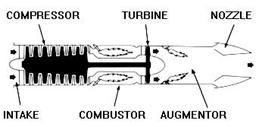
A turbojet engine.
The turbojet is the basic engine of the jet age. Air is drawn into the engine through the front intake. The compressor squeezes the air to many times normal atmospheric pressure and forces it into the combustor. Here, fuel is sprayed into the compressed air, is ignited and burned continuously like a blowtorch. The burning gases expand rapidly rearward and pass through the turbine. The turbine extracts energy from the expanding gases to drive the compressor, which intakes more air. After leaving the turbine, the hot gases exit at the rear of the engine, giving the aircraft its forward push... action, reaction !
For additional thrust or power, an afterburner or augmentor can be added. Additional fuel is introduced into the hot exhaust and burned with a resultant increase of up to 50 percent in engine thrust by way of even higher velocity and more push.
The Turboprop/Turboshaft Engine
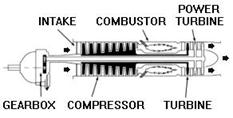
A turboprop, or turboshaft engine.
A turboprop engine uses thrust to turn a propeller. As in a turbojet, hot gases flowing through the engine rotate a turbine wheel that drives the compressor. The gases then pass through another turbine, called a power turbine. This power turbine is coupled to the shaft, which drives the propeller through gear connections.
A turboshaft is similar to a turboprop engine, differing primarily in the function of the turbine shaft. Instead of driving a propeller, the turbine shaft is connected to a transmission system that drives helicopter rotor blades; electrical generators, compressors and pumps; and marine propulsion drives for naval vessels, cargo ships, high speed passenger ships, hydrofoils and other vessels.
The Turbofan Engine

A high bypass turbofan engine.
A turbofan engine is basically a turbojet to which a fan has been added. Large fans can be placed at either the front or rear of the engine to create high bypass ratios for subsonic flight. In the case of a front fan, the fan is driven by a second turbine, located behind the primary turbine that drives the main compressor. The fan causes more air to flow around (bypass) the engine. This produces greater thrust and reduces specific fuel consumption.

A low bypass turbofan engine.
For supersonic flight, a low bypass fan is utilized, and an augmentor is added for additional thrust.
| American Literature books summary | |
|
We are lucky to present you Short Summaries of the Books You Have to Read in the course of the English Literature by Stulov Thursday, April 3 2002 ... The mess officer controls the international black market, plays a major role in the world economy, and uses Air Force planes from countries all over the world to carry shipments of ... ex-P.F.C. Wintergreen - The mail clerk at the Twenty-Seventh Air Force Headquarters, Wintergreen is able to intercept and forge documents, and thus wields enormous power in the Air ... |
Раздел: Топики по английскому языку Тип: топик |
| English topics | |
|
The Russian Federation. The Russian Federation is the largest country in the world. It occupies about one-seventh of the earth"s surface. It"s total ... In the central regions show storms and cold are still in power, while in the south people begin to think of spring crops. PG You see, we've already seen two 14-year-old American girls, that's Tracy Austin and Andrea Jaeger, playing at Wimbledon, and now, both at 18, they are now already showing the ... |
Раздел: Топики по английскому языку Тип: топик |
| Tupolev 154M noise asesment (Анализ шумовых характеристик самолёта Ту ... | |
|
Contents 1The Noise Problem 2Effects of Noise Hearing Loss Noise Interference Sleep Disturbance Noise Influence on Health 3Noise Sources Jet Noise ... The increasing volume of air traffic resulted in unacceptable noise exposures near major urban airfields in the late 1960s, leading to a great public pressure for noise control. ,where G is airplane weight, is air density, S is wing area, Cy max is maximum lift coefficient determined from Fig. |
Раздел: Рефераты по авиации и космонавтике Тип: реферат |
| Drug abuse: Tendencies and ways to overcome it | |
|
CONTENTS: Number: Pages: 1. Introduction 2-4 Chapter 1. Concept, Manifestations and Tendencies of Drug Abuse 4-14 2. The Concept and Manifestation of ... Polled experts and narcotic squad police officers, admitted that over the last few years, there was a rise in the number of requests to them by high ranking officials suggesting ... At the recommendation of the special operational group on finances, the UN International Committee on Drug Control called on all governments to pass and effectively use appropriate ... |
Раздел: Топики по английскому языку Тип: топик |
| Africa | |
|
AFRICA, the name of a continent representing the largest of the three great southward projections from the main mass of the earth's surface. It ... AFRICA, the name of a continent representing the largest of the three great southward projections from the main mass of the earth's surface. ... of very high and of very low ground, lands under 600 ft. occupying an unusually small part of the surface; while not only are the highest elevations inferior to those of Asia and ... The occupation of Egypt (1798-1803) first by France and then by Great Britain resulted in an effort by Turkey to regain direct control over that country,5 followed in 1811 by the ... |
Раздел: Рефераты по географии Тип: реферат |